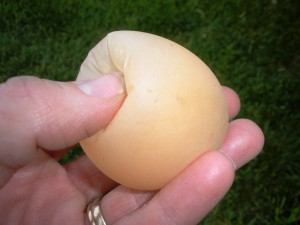Let's Do an “Eggsperiment”!
By Jill Feilmeier on January 10, 2013 in Kid's Health

With the hustle and bustle of school, extracurricular activities and homework, oral health lessons can get put on the backburner. Setting a good oral health example for your children is extremely important. The most chronic childhood disease is tooth decay and it could lead to painful sleepless nights if not prevented.
Encouraging your child to maintain a proper oral hygiene routine should be a parent's priority. The success of your child in school can be affected by tooth decay, so start teaching your children about oral health from a young age.
A fun and easy way to teach older children about the importance of keeping their mouths clean is by having them do the Crest “Eggsperiment”. The “Eggsperiment” uses eggs to represent teeth and vinegar to represent the acids that are made by plaque bacteria, which cause tooth decay and cavities.
Like eggshells, teeth can be weakened by acid, which is why good dental hygiene is so important.
What you'll need:
• 4.6 oz tube of cavity protection toothpaste (active ingredient: sodium fluoride)
• glass measuring cup
• fresh eggs without cracks (use several in case one gets broken by accident)
• ordinary vinegar
• teaspoon
• plastic wrap
• marker
• clear nail polish
• paper towels
Steps:
1. Allow eggs to warm to room temperature. Wash the egg with water and dry with the paper towel.
2. Empty the entire tube contents of toothpaste into the measuring cup and pat down with a teaspoon to level toothpaste and remove any air bubbles.
3. Mark one side of the egg with a marker and cover this mark with clear nail polish to protect it from the vinegar.
4. After the nail polish has dried, place the egg into the measuring cup, marked side down so the toothpaste covers half the egg. Make sure the egg does not touch the bottom of the cup.
5. Cover the cup tightly with plastic wrap and leave it in a safe place at room temperature for at least four full days (96 hours).
6. After the treatment, rinse the toothpaste off the egg with warm tap water and let the egg dry overnight.
7. Pour enough vinegar into the clean measuring cup to cover the egg, and then carefully place the egg into the vinegar with the spoon. Rest the spoon on top of the egg to keep it submerged under the vinegar and then cover the cup with plastic wrap. You'll notice bubbles starting to form on the side of the egg that was not treated with toothpaste.
8. Leave the egg in the vinegar until the untreated side (the unmarked side) of the egg softens. This will take 7 to 13 hours.
9. After 7 hours in the vinegar, remove the egg and check if the side not treated with toothpaste has softened by tapping it very lightly with your finger or a pen. If soft, go on to step 11.
10. If the untreated side is still hard, put the egg back into the vinegar. Check the egg every hour or two afterwards until the untreated shell has softened.
11. When the untreated side is soft, remove the egg and gently wash it with warm tap water. The egg is very fragile now so be careful.
This “Eggsperiment” will show how acid eats away at your teeth and how toothpaste can keep them strong, clean and healthy. Hopefully this visually stimulating “Eggsperiment” will help your child understand why oral care is important!
http://www.crest.com/crest-kids/eggsperiment.aspx